Samsung SSD 840 EVO Review: 120GB, 250GB, 500GB, 750GB & 1TB Models Tested
by Anand Lal Shimpi on July 25, 2013 1:53 PM EST- Posted in
- Storage
- SSDs
- Samsung
- TLC
- Samsung SSD 840
AnandTech Storage Bench 2011
Two years ago we introduced our AnandTech Storage Bench, a suite of benchmarks that took traces of real OS/application usage and played them back in a repeatable manner. I assembled the traces myself out of frustration with the majority of what we have today in terms of SSD benchmarks.
Although the AnandTech Storage Bench tests did a good job of characterizing SSD performance, they weren't stressful enough. All of the tests performed less than 10GB of reads/writes and typically involved only 4GB of writes specifically. That's not even enough exceed the spare area on most SSDs. Most canned SSD benchmarks don't even come close to writing a single gigabyte of data, but that doesn't mean that simply writing 4GB is acceptable.
Originally I kept the benchmarks short enough that they wouldn't be a burden to run (~30 minutes) but long enough that they were representative of what a power user might do with their system.
Not too long ago I tweeted that I had created what I referred to as the Mother of All SSD Benchmarks (MOASB). Rather than only writing 4GB of data to the drive, this benchmark writes 106.32GB. It's the load you'd put on a drive after nearly two weeks of constant usage. And it takes a *long* time to run.
1) The MOASB, officially called AnandTech Storage Bench 2011 - Heavy Workload, mainly focuses on the times when your I/O activity is the highest. There is a lot of downloading and application installing that happens during the course of this test. My thinking was that it's during application installs, file copies, downloading and multitasking with all of this that you can really notice performance differences between drives.
2) I tried to cover as many bases as possible with the software I incorporated into this test. There's a lot of photo editing in Photoshop, HTML editing in Dreamweaver, web browsing, game playing/level loading (Starcraft II & WoW are both a part of the test) as well as general use stuff (application installing, virus scanning). I included a large amount of email downloading, document creation and editing as well. To top it all off I even use Visual Studio 2008 to build Chromium during the test.
The test has 2,168,893 read operations and 1,783,447 write operations. The IO breakdown is as follows:
| AnandTech Storage Bench 2011 - Heavy Workload IO Breakdown | ||||
| IO Size | % of Total | |||
| 4KB | 28% | |||
| 16KB | 10% | |||
| 32KB | 10% | |||
| 64KB | 4% | |||
Only 42% of all operations are sequential, the rest range from pseudo to fully random (with most falling in the pseudo-random category). Average queue depth is 4.625 IOs, with 59% of operations taking place in an IO queue of 1.
Many of you have asked for a better way to really characterize performance. Simply looking at IOPS doesn't really say much. As a result I'm going to be presenting Storage Bench 2011 data in a slightly different way. We'll have performance represented as Average MB/s, with higher numbers being better. At the same time I'll be reporting how long the SSD was busy while running this test. These disk busy graphs will show you exactly how much time was shaved off by using a faster drive vs. a slower one during the course of this test. Finally, I will also break out performance into reads, writes and combined. The reason I do this is to help balance out the fact that this test is unusually write intensive, which can often hide the benefits of a drive with good read performance.
There's also a new light workload for 2011. This is a far more reasonable, typical every day use case benchmark. Lots of web browsing, photo editing (but with a greater focus on photo consumption), video playback as well as some application installs and gaming. This test isn't nearly as write intensive as the MOASB but it's still multiple times more write intensive than what we were running in 2010.
As always I don't believe that these two benchmarks alone are enough to characterize the performance of a drive, but hopefully along with the rest of our tests they will help provide a better idea.
The testbed for Storage Bench 2011 has changed as well. We're now using a Sandy Bridge platform with full 6Gbps support for these tests.
AnandTech Storage Bench 2011 - Heavy Workload
We'll start out by looking at average data rate throughout our new heavy workload test:
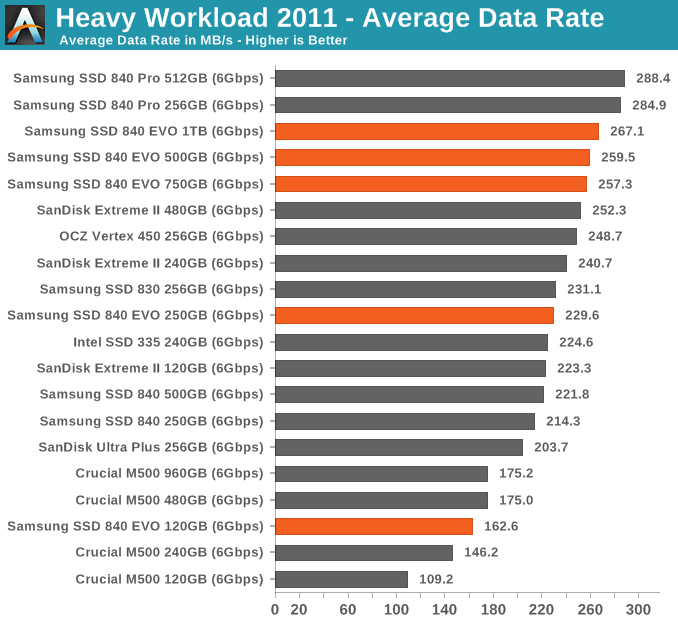
In lighter workloads than our 2013 workload the EVO still does incredibly well.
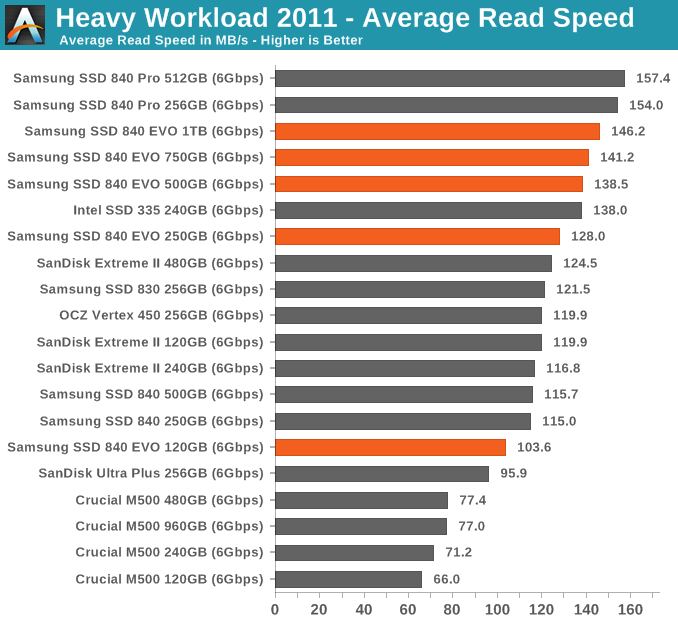
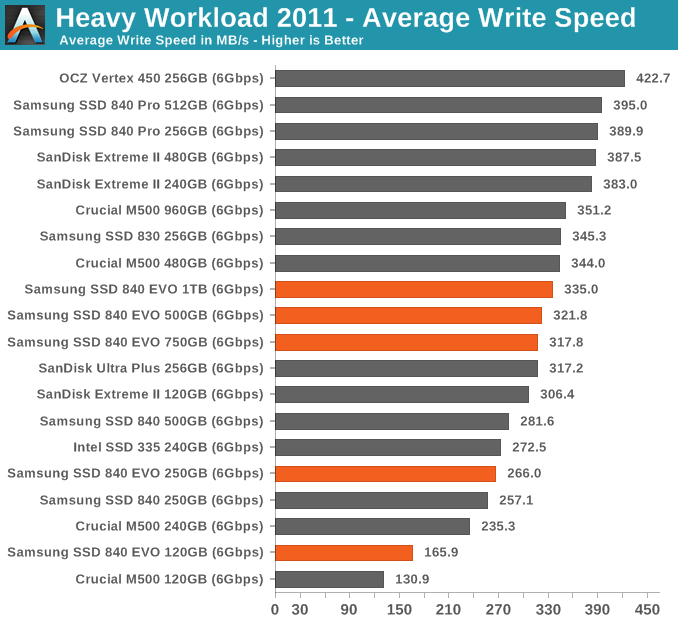
AnandTech Storage Bench 2011 - Light Workload
Our new light workload actually has more write operations than read operations. The split is as follows: 372,630 reads and 459,709 writes. The relatively close read/write ratio does better mimic a typical light workload (although even lighter workloads would be far more read centric).
The I/O breakdown is similar to the heavy workload at small IOs, however you'll notice that there are far fewer large IO transfers:
| AnandTech Storage Bench 2011 - Light Workload IO Breakdown | ||||
| IO Size | % of Total | |||
| 4KB | 27% | |||
| 16KB | 8% | |||
| 32KB | 6% | |||
| 64KB | 5% | |||
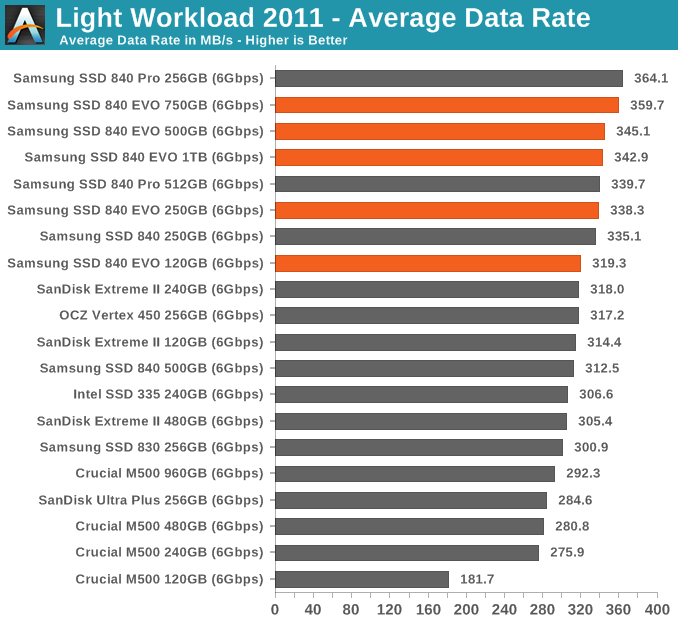
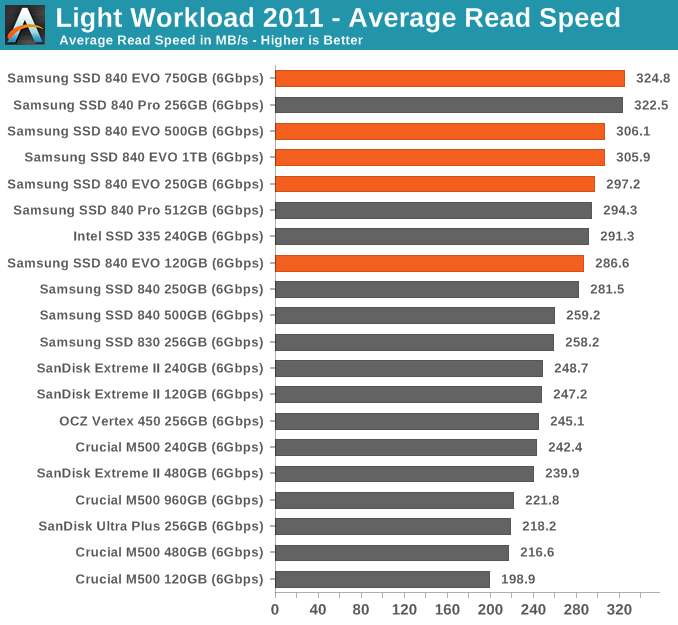
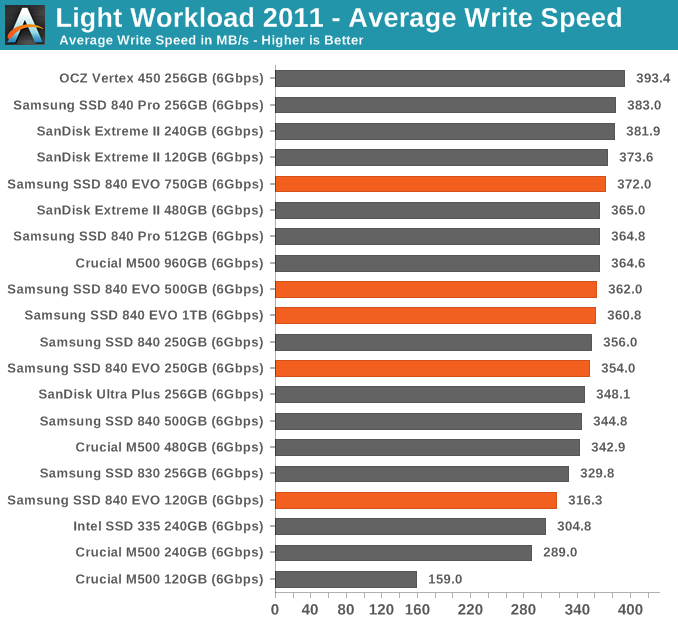










137 Comments
View All Comments
B0GiE-uk- - Thursday, July 25, 2013 - link
Seeing as this drive is similar to the 840 basic, it will be interesting to see the performance of the 840 Pro with the rapid software enabled. Has the potential to be faster than the EVO. I have heard that the rapid software will be backwards compatible.sheh - Thursday, July 25, 2013 - link
Caching speed is based on RAM, flushing speed on drive. I don't think there will be any surprises.Heavensrevenge - Thursday, July 25, 2013 - link
Finally were seeing transition to RAM caches, it's nice a RAM disk is being utilized and I hope the trend continues so that HDD/SDD can actually be taken out of the storage hierarchy for the OS & operating memory and have EVERYTHING reside in a non-volatile RAM space together for CRAZY increases in perf since HDD's in a way are a side-effect of old memory's being so small there had to be a drive backing the RAM. But of course we need traditional storage for actual storage purposes afterwards. But I'll hope for a migration of RAM towards a similarly fast combination of RAM+Drive being the main root drive built right onto the motherboards in a stick-like way within 10 years to cause a nice little computing revolution via re-architecting the classical storage hierarchy that's now, I believe, is quite possible and reasonable.DanNeely - Thursday, July 25, 2013 - link
Modern OSes have been doing ram cache for years. Samsung is able to "cheat" with rapid because they've got a much better view of what the drive is doing internally to optimize for it (even if the data isn't normally exposed via standard APIs). Eventually OS authors will catch up and have SSD optimized caches instead of HDD optimized ones and it will again be a moot point.Jaybus - Thursday, July 25, 2013 - link
Yes. It is doing the same thing as the O/S cache, but using a different algorithm to decide which blocks to cache, one that is tailored to SSD. So the O/S is very likely to adapt something similar in future.What is more interesting is TurboWrite. If you consider the on board DRAM a L1 cache, then TW implements a more-or-less L2 cache in NAND by using some of the NAND array in SLC mode instead of TLC mode. In addition to greater endurance, SLC mode allows much faster P/E cycles than TLC (or MLC). And unlike the DRAM cache, the SLC-mode NAND cache is not susceptible to power failure data loss. It still is not nearly as fast as DRAM, so the L1 DRAM cache is still needed. Encryption would kill performance without DRAM. But because data can be moved from DRAM cache to SLC cache more quickly, it frees up DRAM at a faster rate and increases throughput. So unless writing an awfully lot of data continuously, you essentially get SLC performance from a TLC drive. That is the EVO (lutionary) thing about this drive, much more so than RAPID software.
Heavensrevenge - Thursday, July 25, 2013 - link
Heh yes of course, I mean removing the "hard drive/solid state drive" out of the storage hierarchy completely and putting all OS and cache data into non-volatile silicon where the ram sits today, making all operations go as fast as ramdisk speed, not just have it there as a way to hide latency. like boot from the modules plugged directly into the motherboard and everything :) THATS what I'd love to see, 1-2GB/s 4K read & write speeds all-around not just for special use cases, All because the fab process is becoming small enough o fit the amount of data there we can actually re id f that part of the storage hierarchy if you know what I mean.Spunjji - Friday, July 26, 2013 - link
I think there's always going to be a space for slower, more density-efficient storage in any sensible storage hierarchy. I think what you're looking forwards to is MRAM / PRAM, though. :)Heavensrevenge - Saturday, July 27, 2013 - link
MRAM or any NVRAM is basically the concept I was wanting :) Thank you for the reference!!The day/year/decade that type of memory become our RAM & OS/Boot drive replacement in the storage hierarchy will be the one of the best times in modern computing history.
Honestly all HDD/SDD manufactures should stop wasting their R&D on this type of crap even though SSD's are a wonderful "now" solution to the problem and I'll still recommend them for the time being.
The sooner that type of memory is our primary 1st level storage directly addressable from the CPU the better our modern world of computing will become and begin evolving again.
MrSpadge - Saturday, July 27, 2013 - link
I don't think Samsung is doing anything better here, or working some SSD-magic. They're just being much more agressive with caching than Win dares to be.Touche - Thursday, July 25, 2013 - link
I don't think your tests are representative of most people's usage, especially for these drives. TurboWrite should prove to be a much better asset for most, so the drive's performance is actually quite better than this review indicates.